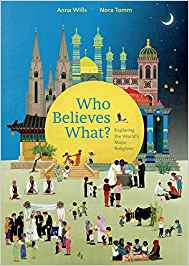Who Believes What? Exploring the World’s Major Religions

Who Believes What? Exploring the World’s Major Religions
Ellen Heaney is a retired children’s librarian living in Coquitlam, British Columbia.
*Who Believes What? Exploring the World’s Major Religions was originally published in German in 2017 as Das Wimmelbuch der Weltreligionen (The Picturebook of World Religions). Translation is by Owlkids editor Shelley Tanaka.
The book begins with a single page headed “What is Religion?” where the ideas of belief, personal leanings and the notion of being part of a faith-based community are outlined. Following this come five chapters on the five major world religions: Hinduism, Judaism, Buddhism, Christianity and Islam.
The format of the book is what sets it apart from the many other volumes for young readers on the subject. Each religion is treated with a two-page written overview, followed by a double spread of illustration with no text, and then another two pages made up of thumbnail pictures describing individual aspects, customs or historical details of the faith under discussion.
To demonstrate, in the section on Buddhism, the first section says:
In Buddhism, there is no creator god as there is, for example, in Hinduism and Judaism. Buddhism was founded by Siddhartha Gautama (sixth to fourth Century BCE). He was born a prince and decided to live his life without luxuries so he could concentrate fully on overcoming suffering. He realized in his search that living a balance life (the middle way) led to happiness and release from suffering.
On the pages which discuss specific points, we can read about the Dharma Wheel or dharmachakra, the spokes of which stand for the Eightfold Path of Buddhism; how Tibetans consider Mount Kailash as a holy place and the axis of the world; and that there are no fixed ceremonies for a Buddhist wedding.
The rich full-colour pictures are crowded with detail, full of a sense of life. They are a source of much information that backs up the text and will reward close scrutiny. In one spread, a Muslim funeral takes place while a few streets away there is a market and an outdoor chess game in progress. The illustrations of Judaic life show, among other things, the stately exterior of a synagogue with yarmulke-wearing boys and men gathered at the entrance, and an outdoor Jewish wedding ceremony. The pictures that accompany the thumbnail entries are elements drawn from the main spreads, but they are rendered in monochrome in a different tone for each religion.
As the layout does not lend itself to the inclusion of an index, such a guide is missing.
Who Believes What? would be a good addition to shelves in school and public libraries, both for the completion of classroom or church school assignments, or for personal enrichment.
